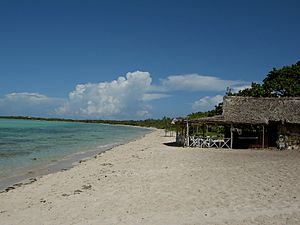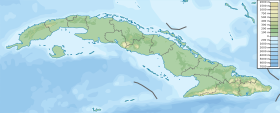Cayo Coco facts for kids
Quick facts for kids
Cayo Coco
|
|
|---|---|
|
Resort island and village
|
|

White sand beach in Cayo Coco
|
|
| Country | |
| Province | Ciego de Ávila |
| Municipality | Morón |
| Elevation | 4 m (13 ft) |
| Time zone | UTC-5 (EST) |
| Area code(s) | +53-43 |
Cayo Coco is a beautiful island located off the north coast of central Cuba. It's famous for its many all-inclusive resorts, which are hotels where your food, drinks, and activities are all included in one price. This island is part of the Ciego de Ávila Province and belongs to a group of islands called Jardines del Rey, which means King's Gardens.
Cayo Coco is managed by the Morón local government. It covers an area of about 370 square kilometers (143 square miles). The island gets its name from the American white ibis, a bird that locals call coco birds. The island is well-known for its long, sandy beaches and the many hotels built for tourists.
Contents
History of Cayo Coco
Early Days and Settlements
Long ago, in the early colonial period, Cayo Coco was a secret hiding spot for buccaneers. These were pirates or privateers who operated in the Caribbean Sea. Later, a small group of people lived on the island. They were mostly fishermen and people who made charcoal for a living.
However, by 1955, the island faced a big problem: its supply of fresh water ran out. Also, after the Cuban Revolution, electricity became more common, so people didn't need charcoal as much. This meant the charcoal business ended, and the small settlement could no longer stay.
Connecting to the Mainland
A major change happened on July 26, 1988. A long road, called a causeway, was built to connect Cayo Coco to the Cuban mainland. This made it much easier to reach the island. After the causeway was finished, construction of tourist resorts began.
The very first resort on Cayo Coco, called Guitart Cayo Coco, opened its doors in 1993. Today, it's known as the Hotel Colonial Cayo Coco.
Cayo Coco in Literature and Nature
Cayo Coco and its nearby island, Cayo Guillermo, were special places for the famous writer Ernest Hemingway. He used these islands as settings for parts of his novels, Islands in the Stream and The Old Man and the Sea.
On September 9, 2017, a very strong storm, Hurricane Irma, hit Cayo Coco. It caused a lot of damage to the hotels and the Jardines del Rey Airport. Nearby towns like Ciego de Ávila and Morón were also affected.
Tourism on Cayo Coco
The Causeway and Wildlife
The causeway that links Cayo Coco to the mainland is about 27 kilometers (17 miles) long. It stretches across a body of water called Bahía de Perros, which means Bay of Dogs. Building this causeway took 16 months and used a huge amount of stone.
At first, environmentalists were worried about the causeway. It changed how the water flowed, which affected the saltiness and temperature of the bay. To help fix this, several gaps were made in the causeway. This allowed some water to flow freely again. Even today, you can often see wild flamingos in the shallow waters of the bay from the causeway.
Island Connections and Hotels
Cayo Coco is also connected to other islands by short causeways. To the west, a causeway links it to Cayo Guillermo. To the east, another causeway connects it to Cayo Romano.
Most of Cayo Coco is still wild. It has swamps and scrubland where wild cattle roam. However, the island is home to about a dozen large international hotels. These hotels currently offer around 5,000 rooms for visitors. There are plans to build even more, with a goal of having 32,000 rooms in the future.
Beaches, Diving, and Airports
The beautiful beaches of Cayo Coco are a big draw for tourists. Off the north coast, there's an enormous coral reef. This reef attracts divers from all over the world who come to explore the amazing underwater life.
Cayo Coco has its own international airport, called the Jardines del Rey Airport. Its airport codes are CCC for IATA and MUCC for ICAO. Since 2005, tourists can fly directly to this airport on Cayo Coco. Before this airport was built, tourist flights landed at the Máximo Gómez Airport near Morón on the Cuban mainland.
There was an older airport on Cayo Coco, but it has been turned into a small nature park called Parque Natural El Baga. This park helps protect the island's natural environment.
See also
 In Spanish: Cayo Coco para niños
In Spanish: Cayo Coco para niños


